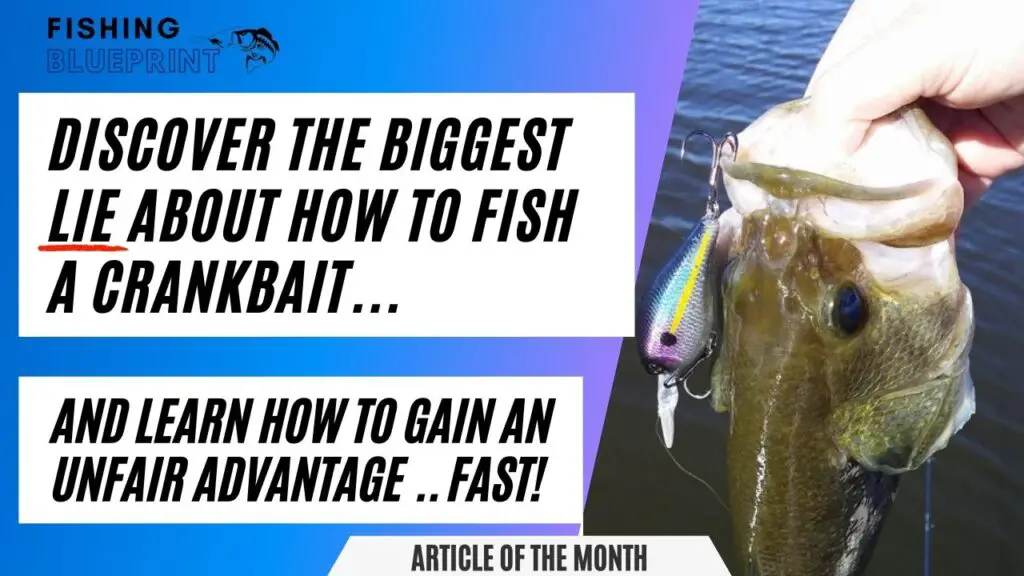Lake Perris Fishing Report
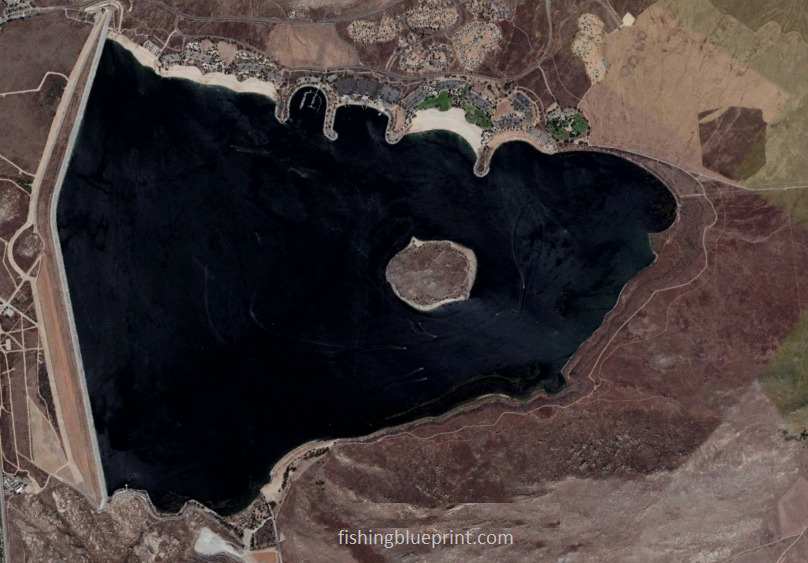
Lake Perris is a small lake that sits 71 miles away from Los Angeles.
Overall it’s a popular lake being nestled in southern California. In this post, you’re going to be given the blueprint to fish this lake.
So what are the best tips for fishing Lake Perris? There are three important factors you must know if you want to know how to fish Lake Perris successfully. First, you need to know what kind of fish is in Lake Perris. Second, it’s important for you to know which part of the lake each species can be found in. Lastly, knowing what are the best baits that work on Lake Perris is vital. However, tactics, baits, and locations will be different for each type of fish that you target. So let’s talk about the steps you need to take in order to give you the best chance of catching a fish on Lake Perris.
About Lake Perris

Lake Perris is a shallow body of water with the average depth being 35 feet and a maximum depth of 100 feet when the lake is completely full.
Fishing Lake Perris can be incredible when you have over 2,250 surface acres and 10 miles of shoreline of shoreline to fish.
Lake Perris gives locals and visitors the opportunity to test their luck in catching one of the many game species this lake has to offer
Important Lake Warnings
Algae blooms may be present which may affect fishing, swimming, and water contact in general.
According to parks.ca.gov, “every one of California’s new laws requires boat operators to have a California Boating Card. The card is required for anyone under the age of 41 to operate a boat in California’s waters.”
If you are fishing and camping, fire bans may be in effect due to the ongoing drought conditions.
What Kind Of Fish Are In Lake Perris
Rainbow trout
Largemouth bass
Black crappie
White crappie
Catfish
Bluegill
Common carp
Lake Perris Fishing Tips & General Strategies
If you’re lookin’ to get hooked on some fine bass fishin’, you’ve gotta hit up Lake Perris in California! This spot is all about the reel deal, and I’m here to fill you in on what to expect. So buckle up, buttercup, and let’s dive into the deep end.
Water Clarity:
If you’re wonderin’ what to expect from the water clarity, you’re in for a treat. Lake Perris serves up some:
- Variable clarity: Depending on the season and weather, water clarity can range from gin clear to stained. So be ready to adapt your tactics, amigo!
Structures & Cover:
Like any self-respecting bass haven, Lake Perris has got some prime real estate for our green and brown friends. Here’s the lay of the land:
- Rock on! You’ll find plenty of rocky points and ledges around the lake. So, make sure to pack those jigs and Texas-rigged worms to flip and pitch like a boss.
- Timber! Fallen trees and stumps provide the perfect ambush points for those lunker bass. Don’t be afraid to skip a Senko or buzzbait under those logs and branches.
- Weeds, glorious weeds: Nothing says bass cover like a hydrilla bed or some good ol’ coontail. Swimbaits and spinnerbaits are your friends here; just be sure to give ’em the ol’ heave-ho.
- In the Tules: These tall, reed-like plants are bass magnets. Get ready for some froggin’ and punchin’ action, my friend.
- Docks and Marina: Lake Perris has a marina and a fair number of docks around it. Get ready to dock talk with your fellow anglers while you drop shot your way to bass glory.
Springtime Fishing update
I just got the lowdown on springtime fishing at Lake Perris from a fellow angler. Here’s what they’ve experienced during spring:
Average Water Clarity:
- Early Spring (March): Expect to fish in stained to slightly murky water, with 2-4 feet visibility.
- Mid-to-Late Spring (April-May): However, they did mention that clarity gradually improves to clearer conditions, with 4-6 feet visibility.
Average Water Temperature:
- Early Spring (March): Typical early spring temperatures ranging from 55°F to 60°F.
- Mid Spring (April): Water temperature typically increases to between 60°F and 65°F.
- Late Spring (May): Temps continue to rise from 65°F to 70°F.
Fishing Techniques:
- Sight Fishing: Reports from other anglers tell me that as water clarity improves, sight fishing becomes an effective technique for targeting bass during the spawning season.
- Flipping and Pitching: A lot guys have been having success with focusing their time on flipping and pitching around shallow cover such as tules, fallen trees, and docks.
- Crankbaits: Others I noticed really pounding the rocky banks using shallow and medium-diving crankbaits to cover water and locate active fish around rocky points, ledges, and transitions.
- Topwater: In late spring/ post-spawn anglers report success with topwater lures like frogs, buzzbaits, and poppers, generating explosive strikes in shallow vegetation and around structures as water temperature increases.
Baits:
- Soft Plastics: The angler suggests using Senkos, Texas-rigged worms, and creature baits around cover and in vegetation. They recommend experimenting with different colors.
- Spinnerbaits and Vibrating Jigs: These lures have been great for covering water and attracting fish in stained and windy conditions. War Eagle or Nichols spinnerbaits are great choices, and Z-Man Jackhammer or a Z-Man Chatterbait Elite are great choices for vibrating jigs.
- Swimbaits: Once the water starts to clear up throwing a swimbait along the banks and through the weeds is a great lure choice.
- Jigs: They’ve found finesse jigs and flipping jigs to be effective around rocky structures and heavy cover for enticing bites.
- Topwater Lures: Frogs, buzzbaits, and poppers are their top choices for generating surface action around shallow cover and vegetation.
Lake Perris – Summer Fishing update
Summer fishing at Lake Perris has been going off chain. I asked some Inner Circle members on the low down how this lake was fishing. Here’s what they reported back to me:
Average Water Clarity:
- Summer: Water clarity typically ranges from clear to slightly stained, with 6-10 feet visibility.
Average Water Temperature:
- Early Summer (June): 70°F to 75°F
- Mid-to-Late Summer (July-August): 75°F to 80°F
Wind/Weather Conditions:
- Summer days have been hot and sunny, with occasional afternoon wind gusts. Mornings and evenings have proven to give us the best fishing conditions due to cooler temperatures and lower wind conditions.
Fishing Techniques:
- Open Water Fishing: Reports that as the water temperatures rise, these bass will move to deeper, cooler water. Drop shot, Carolina rigs, jigs, and deep-diving crankbaits have been effective.
- Topwater: Early mornings, late evenings, and overcast clouds are prime times for topwater action, especially around shallow cover and vegetation.
- Structure Fishing: They suggest targeting offshore humps, points, and ledges with jigs, shaky heads, and football-head jigs.
Baits:
- Drop Shot: Roboworm Straight Tail Worms and Zoom Finesse Worms are popular choices.
- Topwater: Whopper Ploppers by River2Sea, Zara Spooks by Heddon, and Hollow Body Frogs by Booyah or SPRO are the go-to lures.
- Jigs: Strike King Tour Grade Football Jigs and Missile Baits Ike’s Mini Flip Jigs are effective around rocky structures.
Where to fish this Summer:
- Dam Area: Fish deep water near the dam with drop shots or Carolina rigs.
- Bernasconi & Climbing Rock Cove: Target shallow cover and vegetation in this area with topwater lures and soft plastics.
- Rocky Points: Fish the numerous rocky points around the lake with jigs and deep-diving crankbaits.
I go into more detail in these spots in the article below.
Other critters you can catch
Summer at Lake Perris offers great opportunities to reel in not just bass, but also crappie, trout, and catfish. Here’s a quick rundown of the top techniques for each species:
Crappie:
- Jigging and Tubes: Use small jigs like Bobby Garland Baby Shad or Strike King Mr. Crappie in the 1/16 to 1/32 oz range around submerged brush piles, docks, and tules. Small tube jigs or curly-tail grubs in bright colors (white, chartreuse, or pink) have been working well.
- Live Minnows: Rig minnows under a slip bobber and slowly drift around structure to entice crappie.
Trout:
- Trolling: Troll with small spoons like Kastmasters, Thomas Buoyants, or Needlefish at a depth of 15-30 feet in cooler, deeper water.
- Drift Fishing: Drift PowerBait, nightcrawlers, or salmon eggs in deeper water or close to the thermocline.
- PowerBait: Cast out and let Berkley PowerBait Trout Bait or Gulp! Floating Trout Worms sit on the bottom in deeper areas where trout are likely to be found during the summer.
Catfish:
- Stink Baits: Use prepared catfish baits like Catfish Charlie or Magic Bait Catfish Dough around deeper holes, drop-offs, and submerged structures.
- Cut Bait: Rig cut bait (bluegill, shad, or mackerel) on a Carolina rig or slip sinker rig and cast out to deep water or near cover.
But Where Are The Best Places To Fish At Lake Perris?
And in no particular order here is that list of the best fishing spots at Lake Perris.
DISCLAIMER: The material provided is for general information purposes only. It’s important to understand that any information provided in this article can change at any time. Any maps or graphics featured are not to be used as navigational aids. Fishing Blueprint will not be responsible for any personal injury or property damage from any misuse of the maps or graphics provided. It’s completely impossible to give you every single spot where you can potentially catch a fish. But, what this list does do is to give you a helping hand and narrow down to the most productive fishing spots.
East End Flats
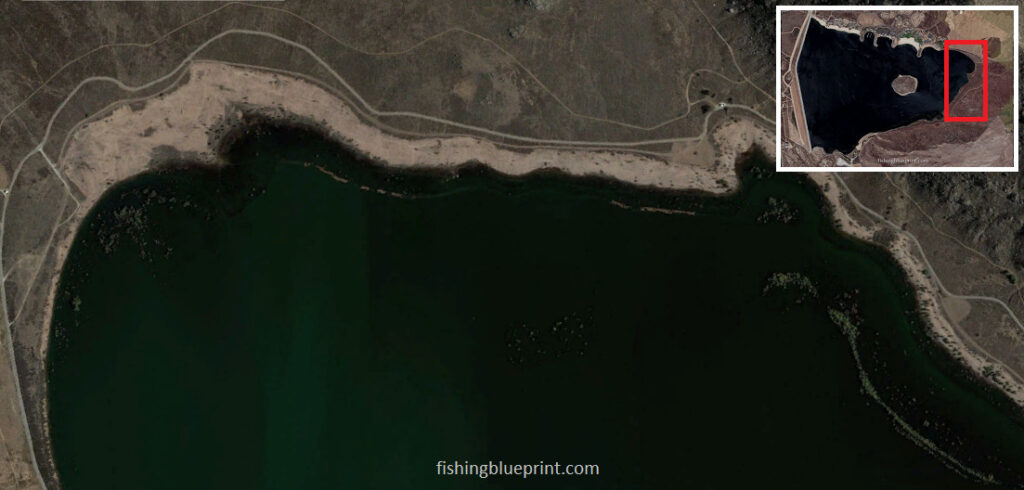
“Grass flat” is a great way to describe this place. It’s a pretty big place that doesn’t change much in depth and is full of plants. This plant life can sometimes grow up to the top, making a floating mat or canopy.
When the weeds are just starting to grow or are dying off, this huge flat is a great place to fish because it makes deep pathways in the plants. Bass will hide in holes full of weeds and wait for food there.
It’s not very deep (between 3 and 10 feet), but the fish can hide and make this place their home because of all the cover. Some parts of the flat are close to deep water, so fish can swim there if they feel threatened. When you fish on the outside edges, you can often catch fish.
Also, there are some places in this area where the weedbed will get big “holes.” Most of the time, bass will live in these open places.
Use a grass turning jig, a wacky rig senko, a Mojo rig, a Texas rig, weedless tubes, or even a drop shot to fish in holes.
If the grass is underwater, use a topwater lure, buzzbait, frog lure, chatterbait, or whopper plopper to fish over the tops.
Use crankbaits, lipless crankbaits, spinnerbaits, frog lures, soft plastic swimbaits, umbrella rigs, swim jigs, underspin jigs, or chatterbaits to fish along the edges of the weedline.
There are a few places with hard bottoms, small rock piles, and high spots on humps that should be checked for fish.
Last but not least, there are a few small drainage ditches that should also be checked for fish.
Located: east side
Structural features: emergent and submerged brush and weedbeds
Best species to target: largemouth bass, crappie, sunfish
Most effective way to fish this spot: boat, kayak, float tube
The Rock Pile
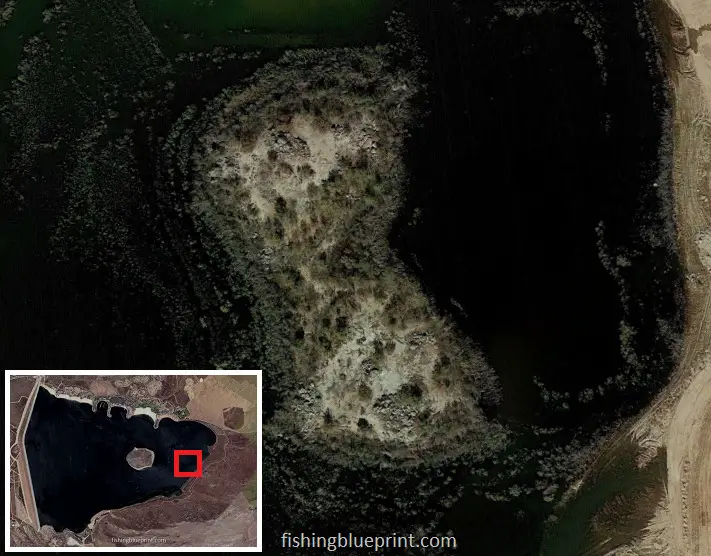
The Rock Pile is a place with two huge piles of rocks. These rock mounds are on the Eastern End Flats. They are bordered by brush and weedbeds that are both above and below the water.
On the east side, next to the Rock Pile, is a place called the Rockin Hole. It is a deep, man-made hole that quickly drops into about 40 feet of water.
The Rock Pile is a great place to fish all year, but the summer is when it really shines.
West of the rock pile, there is a small creek passage that always has fish in it during the winter.
Crawfish, bluegill, minnows, and shad come to this spot to hide.
Because this embankment is so big, it’s best to work on cuts, points, boulder piles, and places where rocks change from being big to small.
Located: east side
Structural features: two giant rock mounds, open sink hole, emergent and submerged brush and weedbeds
Best species to target: largemouth bass, crappie, sunfish
Most effective way to fish this spot: boat, kayak, float tube
Alessandro Island
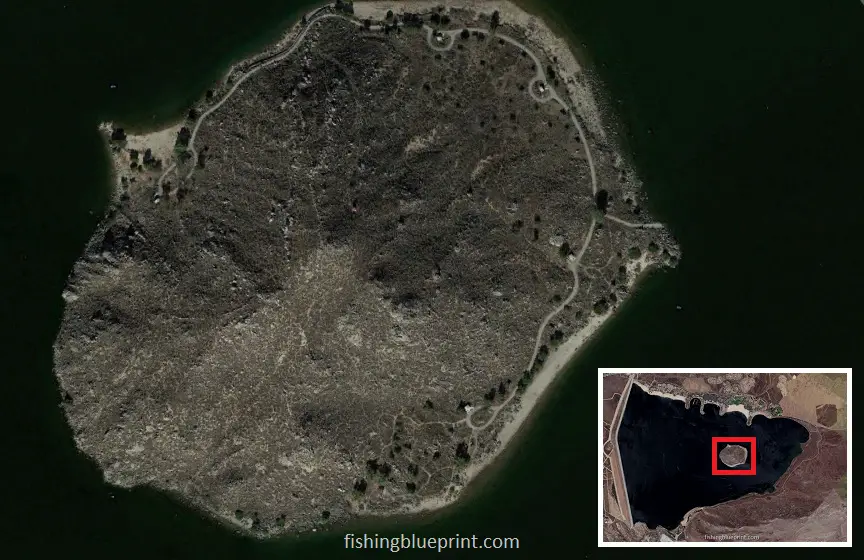
Alessandro Island is about 570 yards long and is in the east of the lake. It is known for having great fishing all year long.
Like the Rock Pile, most of its sides can be made of thick chunks of rock, but in some places they change into sand and clay.
Alessandro Island is also surrounded by both exposed and underwater brush and weedbeds. The eastern side of the island has small thickets of submerged wood.
The upright patches of trees in this area can hold fish at any time of year.
Bass and crappie often hang out over the trees before and after the spawn because of where it is in relation to the other shorelines and how easy it is to get to deeper water.
During the summer, bass will stay near the trunks of bigger trees or over the treetops if they are underwater.
Most locals and guides will start fishing from trees that are far away from other trees, trees that naturally form a point, or trees near deep water.
Then, most people will fish in the woods by focusing on the biggest trees.
Topwater lures, buzzbaits, crankbaits, chatterbaits, soft plastic swimbaits, spinnerbaits, jerkbaits, swim jigs, hair jigs, and underspin jigs are all good baits for this area when the bass are hungry. When used over any deep building or vertical wood, flutter spoons work well as well.
If the bass are shy, you can catch them with drop shot, tubes, Ned rig, Neko rig, Mojo rig, Carolina rig, and football jigs.
Located: east side
Structural features: rocky banks, emergent/ submerged brush and weedbeds, small thickets of submerged timber
Best species to target: largemouth bass, crappie, sunfish
Most effective way to fish this spot: boat, kayak, float tube
Tire Reef
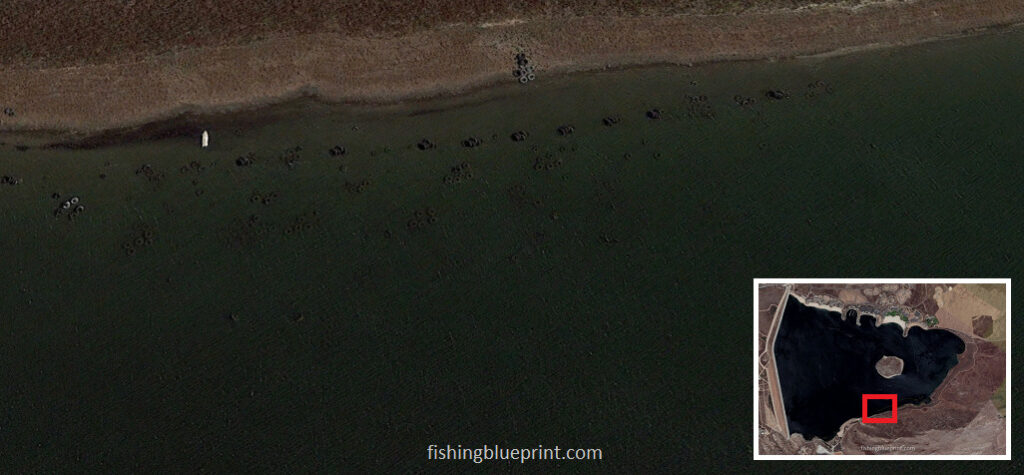
This spot is great because it’s a “structure flat” of artificial habitat. It’s a fairly large area formed of old tires used when the dam was being built.
The area has very little change in depth and fishing can be insane if the water is low, or during the summer and winter months (if the lake is at normal pool level).
If the water is low this spot can be a phenomenal place to catch spawning bass.
Fishing the outside edges can frequently result in fish being caught.
Located: mid-lake, east side
Structural features: artificial habitat
Best species to target: largemouth bass, crappie, sunfish
Most effective way to fish this spot: boat, kayak, float tube
Bernasconi & Climbing Rock Cove
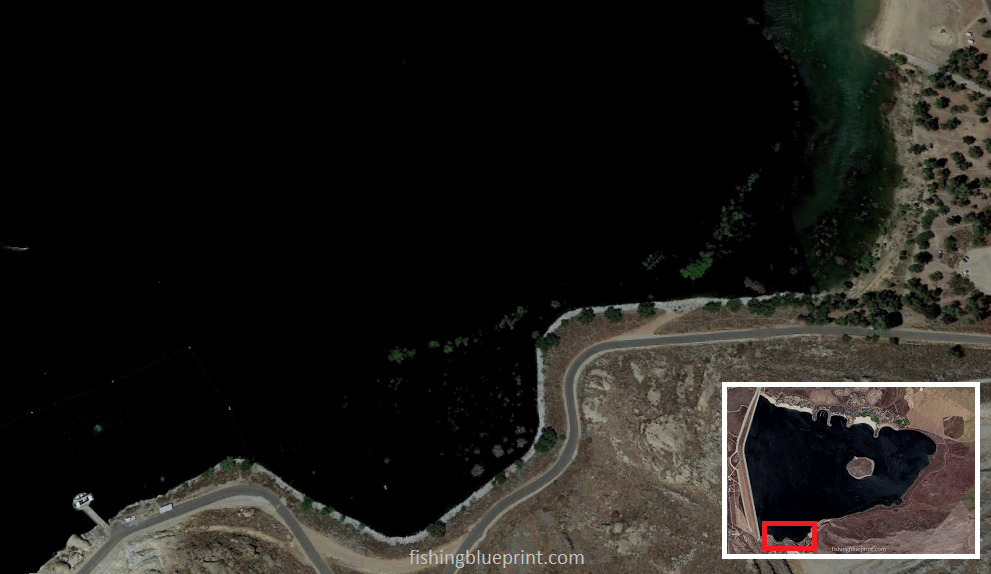
Both winter and summer are great times to fish at these two spots.
When the water level is average, the shallow trees and brush are flooded.
it isn’t uncommon to find weed beds that grow 20 to 30 feet deep. and sometimes the weeds can grow up to the top and form a floating mat or canopy.
When the weeds are just starting to grow or are dying off, this huge flat is a good place to fish because it makes deep pathways in the plants. Bass will hide in holes full of weeds and wait for food there.
Use a grass jig, a wacky rig senko, a Mojo rig, a Texas rig, weedless tubes, or even a drop shot to fish in holes.
If the grass is while submerged, use a topwater lure, buzzbait, frog lure, chatterbait, or whopper plopper to fish over the surface.
Use crankbaits, lipless crankbaits, spinnerbaits, frog lures, soft plastic swimbaits, umbrella rigs, swim jigs, underspin jigs, or chatterbaits to fish along the edges of the weedline.
Check a few places with hard bottoms, small rock piles, and high spots on humps for fish.
Last but not least, there are a few small drainage ditches that should also be checked for fish.
Located: east side
Structural features: emergent and submerged brush and weedbeds
Best species to target: largemouth bass, crappie, sunfish
Most effective way to fish this spot: boat, kayak, float tube
Rip Rap Points

There are several long points in the north of the lake. The tips of these points are covered with thick chunks of rock, which can be anything from small pieces to rocks the size of a basketball. This type of rock is called “rip rap” and can come in any size.
The points are usually steep, and crayfish, bluegill, minnows, and shad come here to hide. This draws bass and other fish that eat smaller fish to the area.
It’s best to focus on cuts, piles of rocks that make a “point on the point,” the biggest boulders in the area, and the places where bigger rocks change to smaller ones.
During the summer, top-water baits work best an hour before and after sunrise or sunset. A good plan for the middle of the day is to go back to this spot and use a fish finder to look for the thermocline. The bass will probably stay just a few feet above the thermocline. Once you know where they are, you can fish near them with a bait that can be used at that depth.
Located: north side
Structural features: rip rap points
Best species to target: largemouth bass, crappie, sunfish
Most effective way to fish this spot: boat, kayak, float tube, shoreline fishing
Boat Ramps at Lake Perris

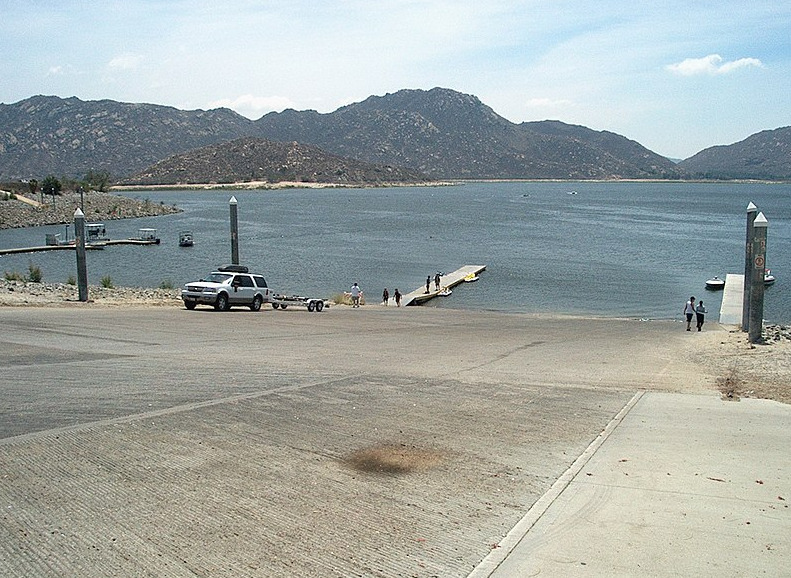
Lake Perris Launch Ramp 6
Moreno Valley, CA 92555
Lanes: 5
Restrooms: Yes
Fish Cleaning Station: Yes
Camping nearby: Yes
Marinas at Lake Perris
Lake Perris State Recreation Area & Marina
17801 Lake Perris Dr, Perris, CA 92571
(951) 940-5600
Nearby boat ramp: Yes
Restrooms: Yes
Showers: no
Groceries/snacks available: Yes
Electric: No
Camping nearby: No
Tackle Shops Near Lake Perris
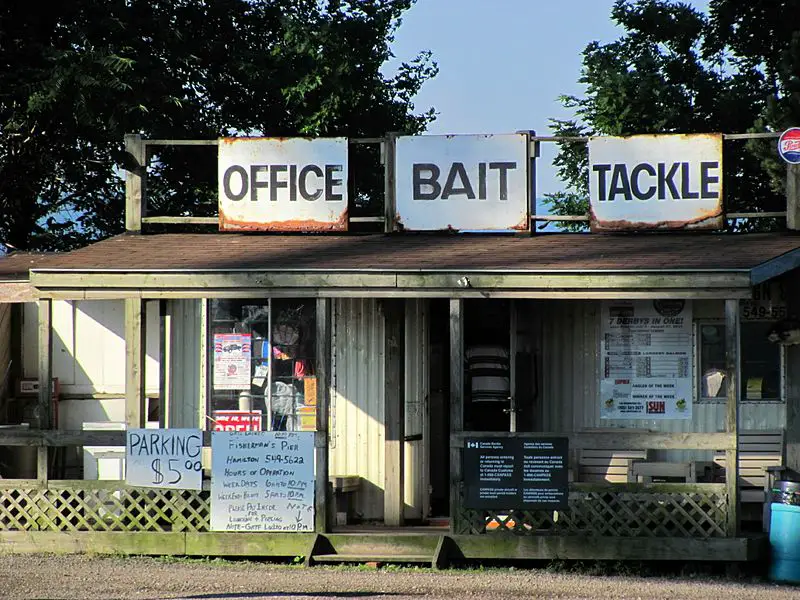
Lakeside Market
4164 N Perris Blvd a, Perris, CA 92571
(951) 943-4364
Last Chance Bait & Tackle
3356 Wentworth Dr, Hemet, CA 92545
lastchancetackle.com
(951) 658-7410
Frank’s Bait & Tackle
12142 California St, Yucaipa, CA 92399
buyfrankstackle.com
(909) 855-2911
Sportsman’s Warehouse
2585 Tuscany St, Corona, CA 92881
stores.sportsmans.com
(951) 382-7100
Camping Near Lake Perris
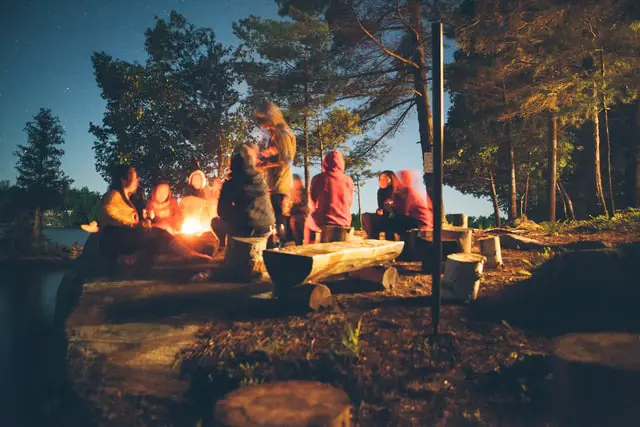
Lake Perris is blessed with an abundant amount of campgrounds that cater to RVer’s and standard tent campers.
They offer 432 sites spread over five separate campsite loops; Quail Loop, Roadrunner Loop, Coyote Loop, Deer Loop, and Bobcat Loop.
Most campgrounds offer visitors level parking, picnic tables and fire pits. Drinking water and flush toilets are provided.
RV sites can feature full or partial hookups.
Fortunately, most campgrounds are pet friendly, but you must keep your fur-buddy on a leash at all times.
Here is a list of both RV/tent campgrounds and boat-in campgrounds.
Lake Perris Campground – Map & Reservations
Other California Related Fishing Articles
- Bass Lake Fishing Report
- Clear Lake Fishing Report
- Castaic Lake Fishing Report
- California Delta Fishing Report
- Diamond Valley Lake Fishing Report
- Don Pedro Reservoir Fishing Report
- Eagle Lake Fishing Report
- El Capitan Reservoir Fishing Report
- Lake Berryessa Fishing Report
- Big Bear Lake Fishing Report
- Folsom Lake Fishing Report
- Irvine Lake Fishing Report
- Lake Almanor Fishing Report
- Lake Camanche Fishing Report
- Lake Isabella Fishing Report
- Lake Havasu Fishing Report
- Lake McClure Fishing Report
- Lake Oroville Fishing Report
- Lake Perris Fishing Report
- Lake Piru Fishing Report
- Lake Skinner Fishing Report
- Lake Tahoe Fishing Report
- Los Banos Reservoir Fishing Report
- New Hogan Lake Fishing Report
- New Melones Lake Fishing Report
- O’Neill Forebay Fishing Report
- Pardee Lake Fishing Report
- Pyramid Lake Fishing Report
- San Luis Reservoir Fishing Report
- San Vicente Reservoir Fishing Report
- Shasta Lake Fishing Report
- Silverwood Lake Fishing Report
- Trinity Lake Fishing Report
- Whiskeytown Lake Fishing Report
More articles just for you...
Funny Fishing Rules, Laws, and Regulations 2025
Crazy Fishing Laws That Will Blow Your Mind! #7 is INSANE! Strange Fishing Regulations and Laws As silly as hook and rod limits may seem,
EXPOSED! How To Use A Spinnerbait The Right Way for 2025
Are You Wondering How To Use A Spinnerbait? Or How To Work A Spinnerbait Over Grass, Logs, or Points? Well, All These Questions Are Answered
EXPOSED! Best Crankbait Colors for 2025 [Which to Buy & Avoid]
What color crankbait to use? Crankbait Color Chart I just love going into a Bass Pro Shops store and just staring at all the walls
Best Underwater Dock Lights For Fishing – 2025 Buyers Guide
Night Dock Light Fishing For Beginners Dear fellow angler, Does this sound like you? You’re someone who loves fishing but just wants to escape the
15 Best Deep Diving Crankbaits [2025 Buyers Guide – Which to Buy & Avoid]
A Complete Buyer’s Blueprint On The Best Deep Diving Crankbaits for Bass, Walleye, or Striped Bass On The Market Today Fishing deep diving crankbaits can

